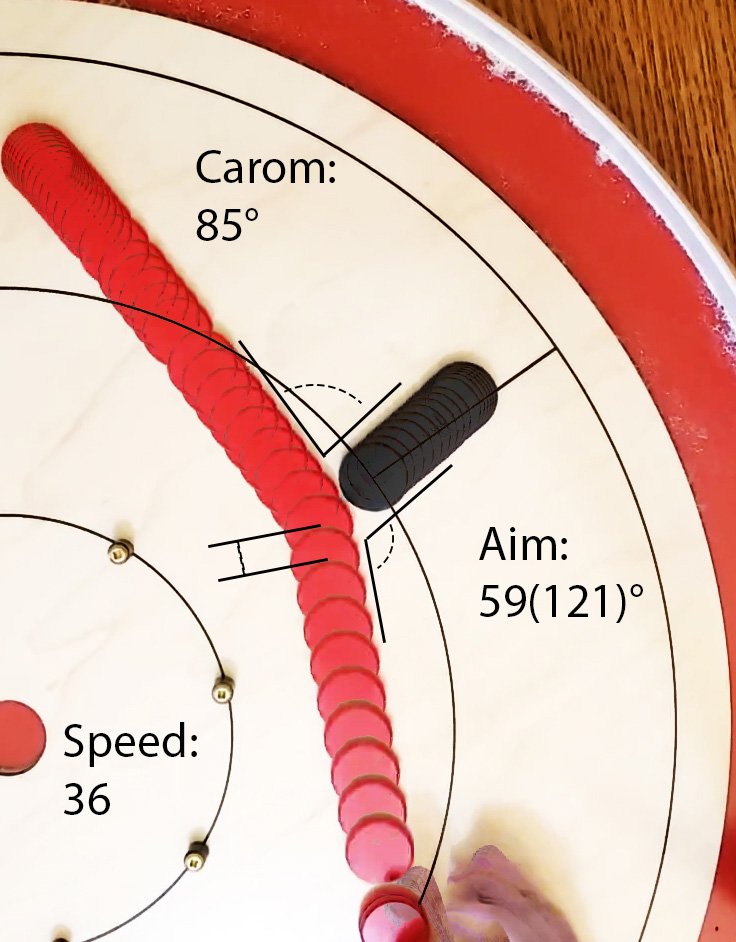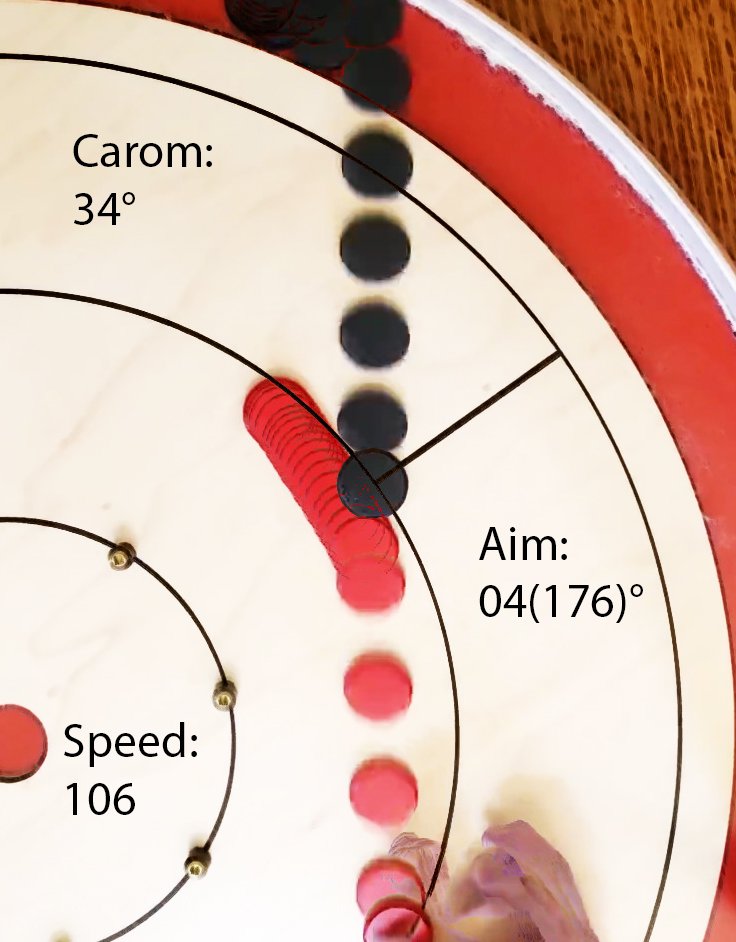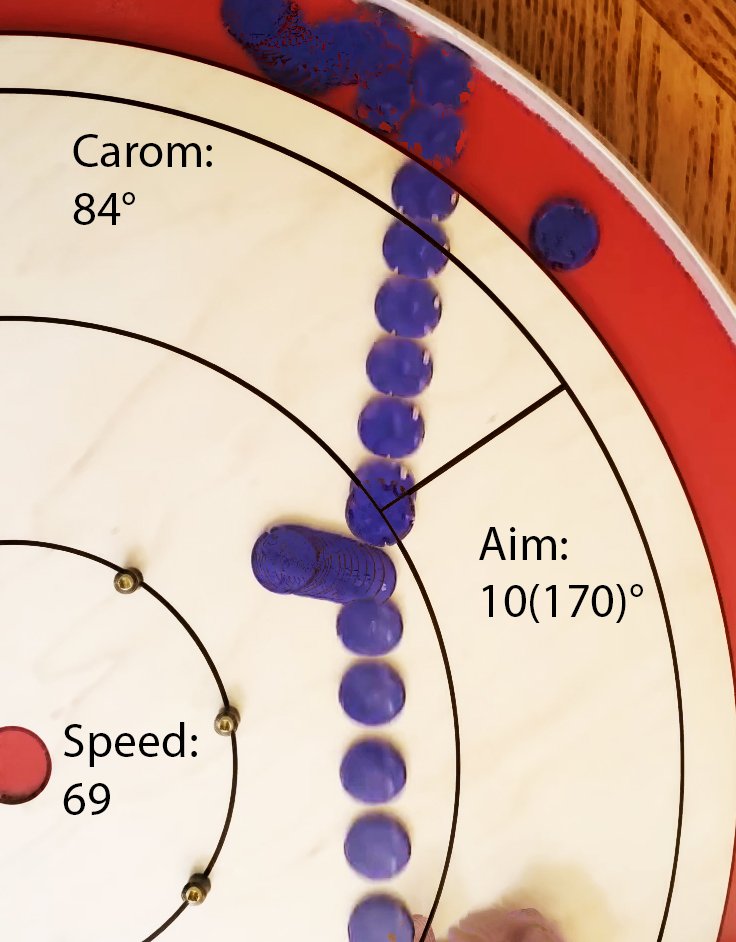Crokinole Angles:
|
 |
 |
| 1a: Slow speed; red disc comes to a complete stop. | 1b: Faster speed; red disc follows-through after contact. |
Depending on your background with Crokinole, other carom games, and classical physics, you might find this perfectly natural or deeply unsettling. As a former competitive pool-player, I tend toward the latter.
|
|
Pool balls don’t show this behavior. A pool ball struck at center (such that it slides across the felt without rotating), that hits an object ball head-on, will come to a complete stop at the point of impact regardless of speed. The collision is said to be elastic, meaning that all the energy of the cue ball is transferred to the object ball. You can get a pool ball to follow through, however, by hitting it above center such that it rotates forward, rolling along the felt, instead of sliding. After the head-on elastic collision, the rotational energy persists and the cue ball will continue to spin forward, in place, until the friction between ball and felt propels the ball further forward. Or, you may choose to draw the ball back toward you after impact, by hitting it below center. The cue-ball spins backwards as it slides forward, comes to a halt at impact, then mysteriously navigates back toward you. (Pool is so great.) |
|
But crokinole discs, being discs, can’t rotate forward or backward as they slide. They are pool balls in Flatland, destined always to be hit at center. And yet, when flicked with sufficient speed, they follow through. Why? Because wooden discs are softer than synthetic polymer pool balls. Wooden discs compress when struck together. Not all of their energy is absorbed upon head-on collision. Their collisions are not perfectly elastic. How does this inelasticity affect other crokinole shots, at different angles, at different speeds? That’s the question this paper investigates. MethodI filmed 250+ crokinole shots, varying speed and aim. Each shot segment was converted to a still image composed of successive video frames superimposed via Photoshop. (Details on camera settings and Photoshop workflow in the appendix.) Exported images were coded for three variables: Speed, Aim, and Carom.
In 2a the thick hit means the black target disc absorbs most of the energy of contact, so the red shooter disc slows down. In 2b the shooter disc barely loses speed after it grazes the target disc. Speed and aim are, theoretically, under the player’s control. The carom angle is what we want to predict, both over the board by feel, and within this paper by way of data. ResultsMichel Cloutier makes a strong claim about the carom angle in his excellent Crokinole: The Illustrated guide. “The 90-degree rule states that when your disc comes in contact with an opponent’s disc it will always rebound at a 90-degree angle.” He provides the following illustration: |
|
This is an effective way to introduce carom angle to a beginner. Cloutier continues, “The great thing about the 90-degree rule is that the rebound will always follow the tangent line regardless of the shooter's angle and the opponent’s disc will always move at a 90-degree angle.” This is an oversimplification. Imagine this were true, and imagine we collected data in the manner described above, and plotted carom angle against aim:
|
|
In the real world, things are different. We have already seen so in the images above (2a;2b). Here is my complete data set, plotted the same way:
|
|
With very thin hits (aim greater than 50, on the right side of the chart), the carom angle approaches but never reaches 90 degrees. As aim decreases to 20 degrees, carom angle slowly decreases with it. With aim below 20 degrees, carom angle drops quickly. Example images below:
| ||||||||||||||
|
The term “follow” is sometimes used to mean only head-on follow-through, or “force-follow.” But we see here that “follow” (the shrinking of the carom angle) affects all shots. Most dramatically when aim is less than 10, but the effect is always there. Now let’s separate the data by speed:
|
|
While speed does affect carom angle, it is not as strong a predictor as is aim. The examples below are arranged horizontally from thick to thin and vertically from slow to fast:
Note that carom angle could not be measured in the two images on the upper-left. The shooter disc did not travel far enough after impact to be able to determine its path. This is why there are no yellow-colored (slow) data points when aim is less than 10 in Chart 3. Thicker hits produce more follow, but also have more of their energy absorbed by contact. Making the shooter disc travel several inches beyond the point of contact for a head-on shot tests your ability to shoot extremely hard while maintaining perfect aim. An easier route may be to give yourself a slight angle, so that less of your initial speed is absorbed by contact:
Resin DiscsA recent development within the Crokinole scene is the availability of discs made of hard resin instead of soft wood. The discs are pretty: pretty to look at; pretty expensive; and pretty darn resistant to follow-through.
If they don’t follow through, maybe resin discs follow the 90-degree rule? Let’s find out:
Pretty close! Most of the data shows a horizontal line around 85 degrees, regardless of aim. (You might call it the 85-Degree Resin rule.) The examples below illustrate the different effects of aim on carom angle in wood and resin discs:
| |||||||||||||||||||||||||||||||||||||||||||||||||||||||||
ConclusionsExpert players likely already know this material, consciously or subconsciously. But for the aspiring intermediate (like me), there is much to absorb and apply:
Factors not investigated here:
AcknowledgementsThanks to Michel Cloutier for kind permission to use his illustration and quote from his wonderful book, Crokinole: The Illustrated guide. Thanks to David Levy, Benjamin James, and Simon Woodhead for helpful comments earlier drafts. Thanks to Karen Schwartz for tripod help and early photographic experimentation, to Chris Berkman for converting what would have been two tedious hours of solo disc-flicking into one pleasantly social hour by replacing target discs as I shot at them, to Bryan Alberstat for significant Photoshop help, and to Benjamin James for introducing me to this wonderful game in the first place – inside a travel trailer, during a heavy dust storm, at Burning Man. Appendix: Camera Settings and Photoshop WorkflowCrokinole videos were taken with a Galaxy S21 phone on a tripod, at 60 frames per second and a shutter speed of 1/350. This 350/60 ratio of shutter speed to FPS is far higher than the standard practice of 2/1 (e.g. shutter speed of 1/120 for 60 FPS), but I found that at slower shutter speeds the disc images were blurry and hard to measure. Higher shutter speed meant less light, so I raised the ISO to 1600 to compensate. Most photographers dislike the image noise associated with high ISO, but that wasn’t an issue for the purposes of this paper. In Photoshop, I split the videos into singe-shot video segments using the Timeline panel. I used Import Video Frames To Layers to create a single multi-layer .psd file for each shot, then selected all layers, and then selected the Darken blending preset. (Different disc colors may warrant a different blending preset.) I used built-in PS measurement tools to capture speed, aim, and carom values. I made extensive use of Photoshop actions to automate repetitive tasks (but it still took forever). Jeremy Paul Bagai |




























